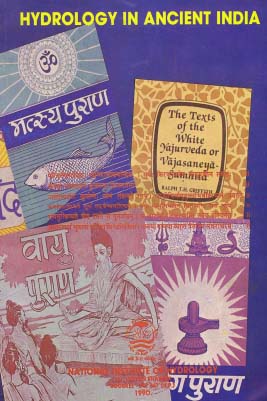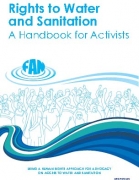Society, Culture, Religion and History
Irrigation in India - Management phases and its sustainability - Paper presented at the National Seminar on Water and Culture (2007)
Posted on 13 Feb, 2011 10:52 PMSince time immemorial water has been a common property and in many Indian communities there is deep reverence for flowing water. Using the flow of water for community benefit is considered an act of great merit and its misuse and contamination, a sin. In temples, tanks were constructed for rituals and also as a way to earn money for the temple.
Coastal Regulation Zone (2011) Notification, Island Protection Zone (2011) Notification and Traditional Coastal and Marine Fisherfolk (Protection of Rights) Act (2009) by the Ministry of Environment and Forests
Posted on 11 Feb, 2011 09:22 PMThe Coastal Regulation Zone (CRZ) notification of 1991 has been replaced recently in January 2011 by the latest CRZ notification of the Ministry of Environment and Forests (MoEF).
Hydrology in ancient India - A book by the National Institute of Hydrology (1990)
Posted on 07 Feb, 2011 11:51 PM It attempts at compiling information on various component processes of hydrology and their interaction. The report has been divided into nine chapters dealing with different aspects of hydrology.
It attempts at compiling information on various component processes of hydrology and their interaction. The report has been divided into nine chapters dealing with different aspects of hydrology.
Like other sciences, the science of water too was well developed in ancient India. The report regrets that at present sufficient attention is not paid to our ancient Indian sciences. The study of Sanskrit literature indicates valuable references to hydrology and important concepts of modern hydrology are scattered in various verses of Vedas, Puranas, Meghmala, Mayurchitraka, Vrhat Sanhita and various other ancient Indian works.
Some of the key references are as follows –
- In vedic age, Indians had developed the concept that water gets divided into minute particles due to the effect of sun rays and wind. At various places in the Puranas it is alluded that water cannot be created or destroyed and that only its state is changed through various phases of hydrological cycle.
- Evaporation, condensation, cloud formation, precipitation and its measurement were well understood in India in vedic and puranic times.
- Effect of yajna, forests, reservoirs etc., on the causation of rainfall, classification of clouds, their colour, rainfall capacity etc, forecasting of rainfall on the basis of natural phenomenon like colour of sky, clouds, wind direction, lightning, and the activities of animals was well developed in ancient India well before 10th century BC.
- Contrivances to measure rainfall were developed during the time of Kautilya (4th century BC) which had the same principle as that of modern hydrology except the fact that weight measure (of drone, paia etc.,) were adopted instead of modern linear measurement of rainfall.
- Scientific facts like arid region of Tibetan rain shadow area and no rainfall by polar winds was discussed in the puranas. The knowledge of monsoon winds and height of clouds along with the division of atmosphere was well developed in vedic age.
- The technique of knowing the slope of an area by means of a flowing river and dimensions of meandering rivers along with velocity of flow were developed.
- In ancient times, Indians had well developed concepts of groundwater occurrence, distribution and utilization. Literature also reveals that hydrologic indicators such as physiographic features, termite mounds, soils, flora, fauna, rocks and minerals were used to detect the presence of groundwater.
- Variation in the height of water table with place, hot and cold springs, ground water utilization by means of wells, well construction methods and equipment are fully described in chapter 54 of Vrhat Sanhita (Bruhat Samhita) named as ‘Dakargala’. The fact that sun rays, winds, humidity, vegetation etc are the major causes of evapotranspiration was well realized.
- Varamihira in as early as 550 AD presented a simple method for obtaining potable water from a contaminated source of water. Various plant materials along with the sun heating, aeration, quenching of water with fire heated stones, gold, silver, iron or sand were used. The change in the quality of water with the months of year and suitability of water from different sources for various uses were described.
- Efficient water use, lining of canals, construction of dams, tanks, essential requirements for the construction of good tanks, bank protection methods, spillways and other minor aspects were given due consideration in ancient times in India.
- Well organized water pricing system was prevalent during the times of Kautilya.
- Various references are available in the Vedas alluding the importance of efficient water use so as to reduce the intensity of water scarcity and drought.

Wetlands (Conservation and Management) Rules 2010 - Welcome, but a lost opportunity - Press release by SANDRP
Posted on 04 Feb, 2011 10:33 AMOn the occasion of the World Wetlands Day 2011, while we welcome the notification of Wetland (Conservation and Management) rules 2010 by the Union Ministry of Env
MGNREGA completes 5 years - PIB Release
Posted on 03 Feb, 2011 01:34 PMAddressing a large gathering at Vigyan Bhawan on this occasion in New Delhi, the Prime Minister Dr. Manmohan Singh called upon the states to strengthen the Gram Sabhas for rural empowerment. He said the Ministry of Rural Development and Ministry of Panchayati Raj has jointly chalked out a plan to strengthen the Panchayats. Technical Units will be set up in Gram Panchayats and to improve the managerial efficiency every unit will have a Panchayat Development officer and one Junior Engineer. Focus would be on Left Wing Extremism(LWE) affected districts and the districts where more than Rs.100 crore have been spent under MGNREGA.
Right to water and sanitation - A handbook for activists by Freshwater Action Network (FAN) Global
Posted on 31 Jan, 2011 10:11 PM With tihs, they can improve water and sanitation service regulation and provision at international, national and local levels. Directed primarily at community groups, human rights NGOs, rights-based development practitioners and aid workers, this handbook aims to strengthen human rights-based advocacy by providing innovative and practical suggestions that activists and organisations can use in their work. It also acts as a resource guide for finding further information.
With tihs, they can improve water and sanitation service regulation and provision at international, national and local levels. Directed primarily at community groups, human rights NGOs, rights-based development practitioners and aid workers, this handbook aims to strengthen human rights-based advocacy by providing innovative and practical suggestions that activists and organisations can use in their work. It also acts as a resource guide for finding further information.
Water and sanitation are essential for living a healthy life with dignity. However, around a billion people across the world lack access to a safe and sufficient water supply to cover their basic needs. Over 2.5 billion people lack access to adequate sanitation and nearly 1.2 billion face the indignity of open defecation every day.
The Millennium Development Goal (MDG) target to halve the proportion of people without sustainable access to safe drinking water and basic sanitation by 2015 is seriously off track, with sanitation severely lagging behind. For example, estimates suggest that at current rates of progress, sub-Saharan Africa will miss the MDG water target by about 25 years, while the sanitation target may not be reached until well into the 22nd century.
Irrigation tanks and their traditional local management - A remarakable ancient history of India - Paper presented at the National Seminar on Water and Culture (2007)
Posted on 31 Jan, 2011 03:20 AMTanks are rainwater harvesting techniques which capture water during monsoons for later use. Mention of tanks in colonial texts is made and the authors infer from ancient texts like Tamil Purananuru on the importance of tanks and the locations for their construction, as well detailing their geographical spread.
Applicability of traditional wisdom in water management in Konkan region of Maharashtra - Paper presented at the National Seminar on Water and Culture (2007)
Posted on 31 Jan, 2011 02:51 AMThe state government's investments in supplying potable water under the Maharashtra Jeevan Pradhikaran (MJP) scheme which envisaged a no tanker supply' end to the scheme is critiqued. The authors note that the project mainly concentrated on asset creation, neglecting operation and maintenance resulting in limited improvement in villages, with respect to water supply.
Dying wisdom of medieval water management of Aurangabad city - Paper presented at the National Seminar on Water and Culture (2007)
Posted on 31 Jan, 2011 01:40 AMThe city of Aurangabad has benefited from the construction of aqueducts and canals by its earlier rulers. According to the authors between 1617 and 1803, a number of aqueducts and canals were constructed.
Glimpses of Bhagiratha Vidya - Irrigation engineering in ancient India - Paper presented at the National Seminar on Water and Culture (2007)
Posted on 31 Jan, 2011 01:33 AMThere is mention of the importance of water in daily life in various prayers in the Rigveda. The author states that the earliest evidence of water conservation goes back to 3000 B. C. when Gabarbands were built in Baluchisthan. The Harappans built tanks and wells and were pioneers of well-digging technology.





